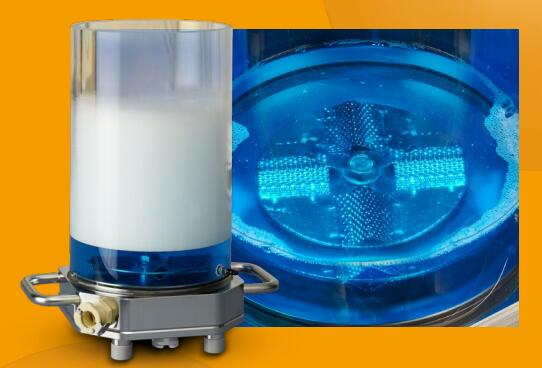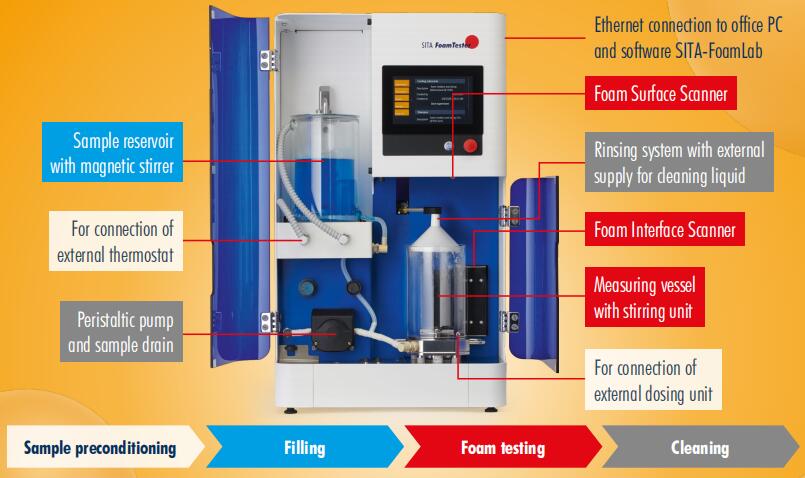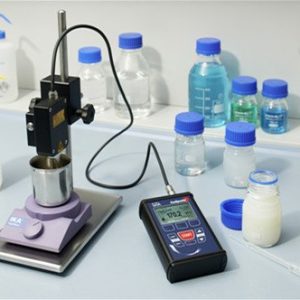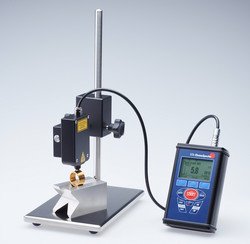The new generation SITA FoamTester—20 Years of Experience Meet the Needs of Innovative Foam Testing
The SITA FoamTester analyses the characteristics of surfactant-containing liquids easily, fast and precisely with automated measuring sequences.
• Fully automated foam analysis
• Precise reproducible foaming
• Innovative optical measuring method
• Measuring foam and liquid volume
• Analysing foam structure
• Recording drainage
• Automated cleaning
Functional components of the SITA FoamTester
Benefits of automated foam testing
• Autonomous repetition of test runs without intervention by the user
• Immediate statements about the reproducibility
• Fast and easy screening of test and sample parameters
Convenient sample handling
• Automatic sample preconditioning (e.g. temperature, the concentration of additives) with external devices
• Integrated sample reservoir with a magnetic stirrer for running multiple test series
• Automated self-cleaning system with external liquid supply (e.g. tap water)
Flexible experimenting
• Easy and free creation of experiments at the office PC by drag‘n‘drop using fully parameterisable device tasks and supportive functions (loops and timers)
• Creating multiple re-usable templates and exactly repeatable test routines to select and start with a single touch at the device
• Instant start with test routines for typical applications pre-defined by SITA
Create foam
Differentiation of various sample formulations and reproducible test sequences using an application-oriented foam creation with proven SITA method

• Established SITA standardized stirring disc
• Variable stirring parameter: speed, duration, acceleration, direction, intervals
• Minor influence of the vessel glass on foam formation
• Removable measuring vessel with stirring unit
Measure foam
Use of optical, contactless measuring methods
• Foam Surface Scanner: Determination of the topography of the foam surface and therefore the total volume using the structured-light method
• Foam Interface Scanner: Determination of the foam structure and the liquid level by optimal use of a movable camera system, which illuminates and observes the measuring vessel at an angle Θ above the critical angle for total internal reflection
• Automatic acquisition of the total volume (liquid and foam) by the Foam Surface Scanner, of the residual liquid volume by the Foam Interface Scanner, and of the foam volume in combination
• Analysis of the foam volume of clear and cloudy liquids
• Recording of the foam structure over the range of 130 mm x 50 mm
• All measurements in the same measuring vessel, connected to the thermal circuit
Analyze foam and understand foaming
• Convenient evaluation of measuring data with the software SITA-FoamLab in the office
• Complete transparency of the measuring progress and the results by intuitive visualization
• Analysis of the slope and the resulting volume during foam formation
• Analysis of the foam decay and the drainage
• Analysis of bubble sizes and shapes in the foam structure
• Comprehensive characterizing of foam and foaming
– By the determination of further parameters such as half-life period and foam density
– By the individual height-dependent evaluation of foam structure parameters such as average bubble size or circularity index
– By tracking time-dependent changes in the foam structure
– Flexible comparison by the clear display of different measuring sequences
– Easy export of data and results for documentation
Application examples of SITA FoamTester
Cosmetics
- Influence of the formulation and raw materials on the foaming behavior
- Foam stability of toothpaste and foam baths
- Foam structure as a reference point for user perception
Cleaning agents
- Influence of temperature on the foaming of spray cleaners
- Influence of contaminations on the foaming in cleaning baths
Cooling lubricants
- Influence of water hardness on the aging process
- Durability of defoamers
- Optimization of the filtration process to prevent foaming
Inks, paints, and coatings
- Effectiveness of defoamers
Liquid processing industry
- Foaming behavior of flow suspension in the paper industry
- Recipe optimization to reduce foaming in bottle filling of beverages
- Adjustment of foaming production auxiliaries in textile manufacturing
- Foaming effects of polymers in plastic production



